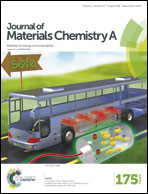A poly-(styrene-acrylonitrile) copolymer-derived hierarchical architecture in electrode materials for lithium-ion batteries†
Abstract
A general methodology is proposed to produce active cathode/anode materials for lithium-ion batteries with a hierarchical structure. In particular, the active electrode materials in nano-dimension (<10 nm) are carbon-coated and encapsulated inside submicron-scale graphite-like carbon spheres derived from a poly-(styrene-acrylonitrile) copolymer prepared by mini-emulsion polymerization. The graphite-like carbon matrix inside the spheres provides high conductivity and mechanical rigidity and keeps well separated the nanoparticles (NPs) of the active materials to avoid their aggregation. The carbon spheres possess mesopores for improving the diffusion of Li ions in and out of the active materials, and for accommodating possible volume changes. The inter-space among the carbon spheres provides continuous channels which facilitate electrolyte infiltration. The proposed methodology has been applied to prepare anatase TiO2/carbon anode materials. The lithium-ion battery prepared using this anode material exhibits a reversible capacity of 173 mA h g−1 at 500 mA g−1, with a negligible capacity fading even after 600 cycles. Moreover, the applied preparation route can be easily scaled up for industrial productions.


 Please wait while we load your content...
Please wait while we load your content...